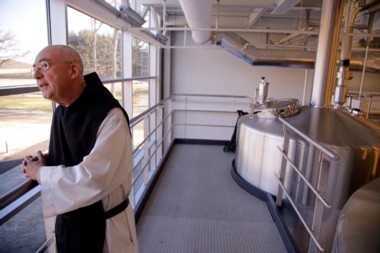Of the 10 breweries recognized by the International Trappist Association as authentically Trappist, six are in Belgium, one in Austria, and two in Holland. Add to that exclusive list St. Joseph’s Abbey, located in Spencer, Mass.
The Bay State has an impressive list of locally brewed beers. But in establishing the first Trappist brewery outside Europe, St. Joseph’s may have transcended the rest.
Not that the monks were necessarily motivated by such an ambition. Catholic Cistercian monks—more commonly known as Trappists—live an ascetic life governed by meditation and work. There is “a certain taste for simplicity, for humility, self-effacement, silence, and in general a refusal to take seriously the aggressivity, the ambition, the push, and the self-importance which one must display in order to get along in society,” author, activist and Trappist monk Thomas Merton wrote in The Way of Chuang Tzu. Nevertheless, theirs is an impressive accomplishment, especially for an American monastery.
Several liquor stores in the Valley report that Spencer Trappist Ale has been very popular this winter, with distribution barely keeping up with the thirsty demand of their customers.
Trappist beers are brewed on monastery grounds for the purpose of financial support. The money made from excess sales goes to charity. Chimay, probably the best-known Trappist beer, was first produced in 1863. St. Joseph’s Abbey began brewing its Spencer Trappist Ale earlier this winter.
Founded in 1951, St. Joseph’s Abbey became synonymous with the Centering Prayer movement when its main teacher, Father Thomas Keating—a Deerfield Academy grad—was elected the monastery’s abbot in 1961.
For 60 years, the monks at St. Joseph’s have produced their Trappist Preserves jams and jellies. But even with that highly regarded, longtime business venture, they wanted greater financial stability.
The idea of a brewery initially came from a monk at St. Joseph’s who had brewed while in college. The more brewing was discussed among the monastic brothers, the more it was seen as a means to a more stable future.
Over a two-year period, brothers from St. Joseph’s visited each Trappist brewery in Europe, learning the intricacies of world-class brewing they would replicate back home in Massachusetts.
For the brewery’s first five years, St. Joseph’s will brew Spencer Trappist Ale exclusively. And production will be modest, the Boston Globe reports, a mere 4,000 barrels a year, which amounts to about 56,000 cases of beer, or 1.3 million bottles. After five years, production will increase to 10,000 barrels a year. But the brewery is capable of turning out 40,000 barrels a year, nearly as much as the 42,000 barrels brewed by Smuttynose.
Spencer Trappist Ale will be sold exclusively in Massachusetts at first, with distribution then expanding nationally, and finally internationally.
The Trappist ale is made from a mere four ingredients: well water from the monastery grounds, hops from the Yakima Valley in Washington state, caramel malt from Wisconsin, and a special variety of yeast propagated at the monastery and first cultured by Trappist monks in the mid-20th century.
The final ingredients and the proportions in which they are brewed were the result of over 20 trial batches. Finally, with suitcase in hand and beer in his suitcase, brewery director Father Isaac Keeley flew to Belgium, shared the Spencer ale, and got the blessing of his European brothers. And with that, Spencer Trappist Ale became an authentic Trappist product.
“A beer brewed with love is drunk responsibly,” the International Trappist Association’s website reads.
Amen.•



